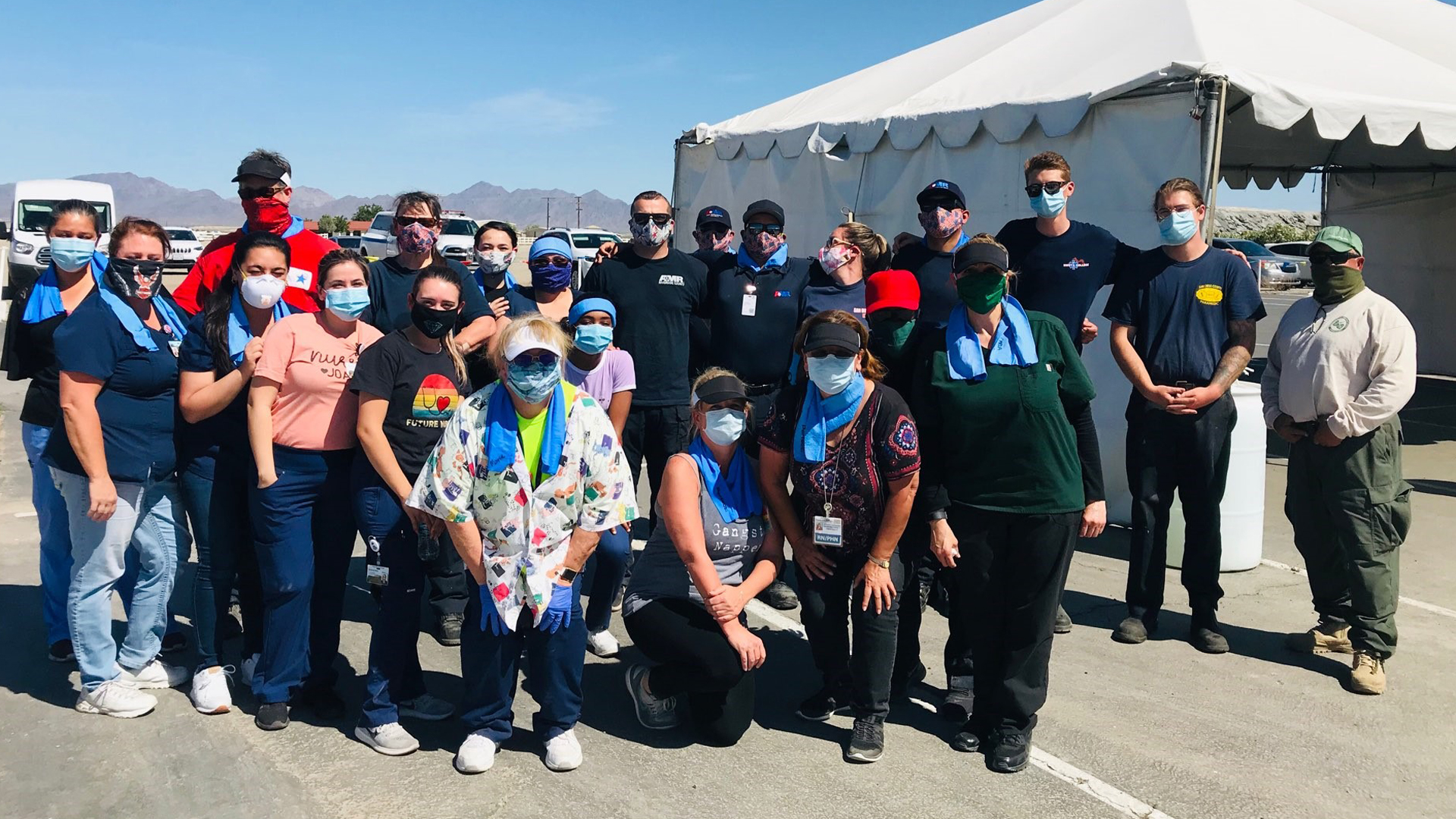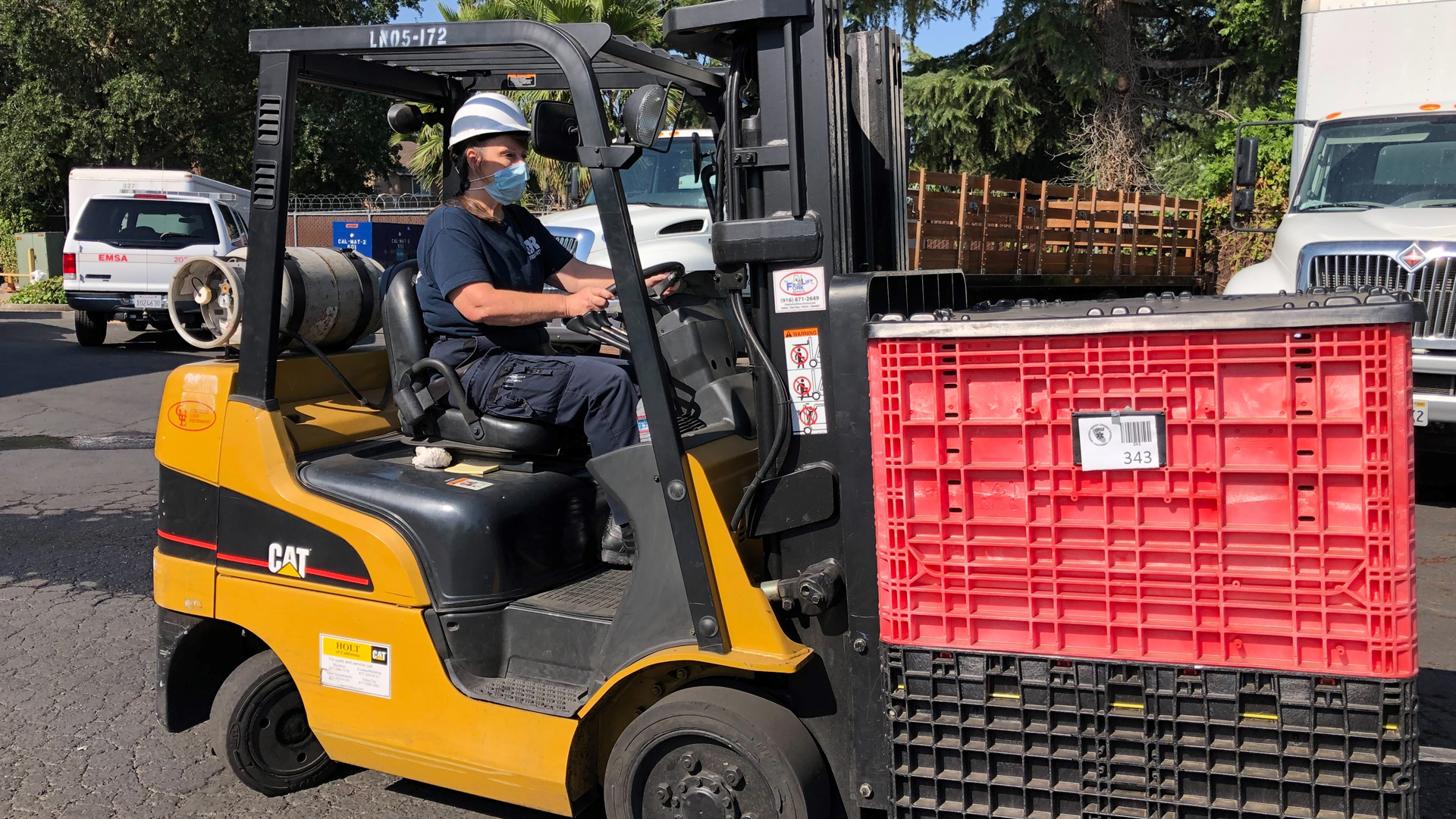Have Heart, Will Travel: AMR Teams Crisscross California to Meet Unprecedented Challenges
November 19, 2020
AMR Teams Crisscross California to Meet Unprecedented Challenges
Lisa La Russo was operating a forklift in a Northern California warehouse. That an American Medical Response paramedic from Southern California had been trained and certified on heavy machinery, and was now using her new-found skills far from home, is part of a larger story.
La Russo is just one of thousands of California EMS professionals who answered the call when the COVID-19 virus hit hard in March of 2020. In April, she was part of an AMR team from San Bernardino, San Diego and Riverside, California, that deployed to other parts of the state to help the pandemic response.
A Tough, Necessary Choice
Volunteering to go where a crisis is occurring is nothing new to La Russo. She has been part of seven FEMA deployments to hurricane-ravaged communities across the Gulf Coast. Those long trips were rewarding but difficult. Being away from her family for weeks at a time was hard.
This time it was a little different. It was still hard to pull herself away from her family—her daughter was a senior in high school and beginning to look at colleges—but the virus, and the risk of being an asymptomatic carrier due to her role as a paramedic, made the decision easier. This time it seemed a brief separation might be in her family’s best interest.
She and her team were sent to Sacramento to work in conjunction with CAL-MAT, a state-coordinated, rapid deployment team of healthcare and support professionals, mobilized to address catastrophic emergencies and operating under the auspices of EMSA. For larger medical deployments, like those for COVID-19, these teams consist of physicians, registered nurses, respiratory therapists, pharmacists, paramedics and EMTs functioning as a stand-alone medical unit.
Packing, Stacking, Coding and Loading
For La Russo and her fellow Southern California team at this stage of their deployment, it was less about clinical care and more about hard work in isolated warehouses. They joined other AMR personnel from around the state packaging ventilators and loading them onto trucks bound for hospitals in the region.
This was critical work. Ventilator shortages at the epicenter of the pandemic, New York City.
Getting these critical machines to people in need was hard work, but a labor of love. As they packed, labeled, coded and loaded the ventilators, they would put a message of hope on the box lid. “Thinking of you” and “Sending our Love” were a couple that she recalls. She and her team wanted opening these vital supplies in New York to be positive, mitigating the grim uncertainty of the early days of COVID-19.
COVID-19 Testing Becomes Critical
Healthcare facilities across the state began to become overwhelmed with patients. The 50-person warehouse team broke up into 10 groups of five to spread out to locations that needed help. They set up mobile hospital sites, raising huge tents and medically configuring the space for the influx of COVID-19 patients. They set up these mobile-care facilities in several California cities including Riverside.
That done, COVID-19 testing became a priority. There was a backlog of patients showing symptoms of the virus that had flooded local hospitals and overwhelmed staff. Working with the California National Guard, they set up a drive-up testing site at the Indio, California, fairgrounds—paramedics applied the swab test while EMTs charted their efforts. Toiling through 12-hour shifts for days, they worked their way through the backlog of patients.
But there was no rest for the weary. Immediately, La Russo and team were whisked off to a community on the California-Arizona border where officials feared testing ws less available. There, in 100-degree heat in the back of a vehicle, in full personal protective equipment, they swab tested and charted 300-500 patients a day over three days.
After six grueling weeks, she stood down and returned home, only to be deployed again to Northern California in July.
A Second Deployment
Back in the warehouse, the strike team again began the arduous task of packing and loading crucial supplies. Some were pulled away to help Porterville, California, by staffing a temporary hospital. Others were re-deployed to support the fire crews fighting wildfires across the state. La Russo was trained as a logistics chief and remained in the warehouse, learning to drive a forklift and working seven days a week to ensure that the many teams strewn across California fighting different yet equally vital battles stayed supplied.
After a few weeks, her deployment and that of others was cut short. Emergency call volumes to local EMS services began to be to rise and were too much too handled with a staff spread out in such a large state. Their own communities needed them now.
La Russo returned to her family. Her daughter had gotten a volleyball scholarship over the summer and was ready to start college life. Things got back to normal—as normal as they could get with the threat of COVID-19 still lingering.
La Russo is just one of thousands of California EMS professionals who answered the call when the COVID-19 virus hit hard in March of 2020. In April, she was part of an AMR team from San Bernardino, San Diego and Riverside, California, that deployed to other parts of the state to help the pandemic response.
A Tough, Necessary Choice
Volunteering to go where a crisis is occurring is nothing new to La Russo. She has been part of seven FEMA deployments to hurricane-ravaged communities across the Gulf Coast. Those long trips were rewarding but difficult. Being away from her family for weeks at a time was hard.
This time it was a little different. It was still hard to pull herself away from her family—her daughter was a senior in high school and beginning to look at colleges—but the virus, and the risk of being an asymptomatic carrier due to her role as a paramedic, made the decision easier. This time it seemed a brief separation might be in her family’s best interest.
She and her team were sent to Sacramento to work in conjunction with CAL-MAT, a state-coordinated, rapid deployment team of healthcare and support professionals, mobilized to address catastrophic emergencies and operating under the auspices of EMSA. For larger medical deployments, like those for COVID-19, these teams consist of physicians, registered nurses, respiratory therapists, pharmacists, paramedics and EMTs functioning as a stand-alone medical unit.
Packing, Stacking, Coding and Loading
For La Russo and her fellow Southern California team at this stage of their deployment, it was less about clinical care and more about hard work in isolated warehouses. They joined other AMR personnel from around the state packaging ventilators and loading them onto trucks bound for hospitals in the region.
This was critical work. Ventilator shortages at the epicenter of the pandemic, New York City.
Getting these critical machines to people in need was hard work, but a labor of love. As they packed, labeled, coded and loaded the ventilators, they would put a message of hope on the box lid. “Thinking of you” and “Sending our Love” were a couple that she recalls. She and her team wanted opening these vital supplies in New York to be positive, mitigating the grim uncertainty of the early days of COVID-19.
COVID-19 Testing Becomes Critical
Healthcare facilities across the state began to become overwhelmed with patients. The 50-person warehouse team broke up into 10 groups of five to spread out to locations that needed help. They set up mobile hospital sites, raising huge tents and medically configuring the space for the influx of COVID-19 patients. They set up these mobile-care facilities in several California cities including Riverside.
That done, COVID-19 testing became a priority. There was a backlog of patients showing symptoms of the virus that had flooded local hospitals and overwhelmed staff. Working with the California National Guard, they set up a drive-up testing site at the Indio, California, fairgrounds—paramedics applied the swab test while EMTs charted their efforts. Toiling through 12-hour shifts for days, they worked their way through the backlog of patients.
But there was no rest for the weary. Immediately, La Russo and team were whisked off to a community on the California-Arizona border where officials feared testing ws less available. There, in 100-degree heat in the back of a vehicle, in full personal protective equipment, they swab tested and charted 300-500 patients a day over three days.
After six grueling weeks, she stood down and returned home, only to be deployed again to Northern California in July.
A Second Deployment
Back in the warehouse, the strike team again began the arduous task of packing and loading crucial supplies. Some were pulled away to help Porterville, California, by staffing a temporary hospital. Others were re-deployed to support the fire crews fighting wildfires across the state. La Russo was trained as a logistics chief and remained in the warehouse, learning to drive a forklift and working seven days a week to ensure that the many teams strewn across California fighting different yet equally vital battles stayed supplied.
After a few weeks, her deployment and that of others was cut short. Emergency call volumes to local EMS services began to be to rise and were too much too handled with a staff spread out in such a large state. Their own communities needed them now.
La Russo returned to her family. Her daughter had gotten a volleyball scholarship over the summer and was ready to start college life. Things got back to normal—as normal as they could get with the threat of COVID-19 still lingering.




